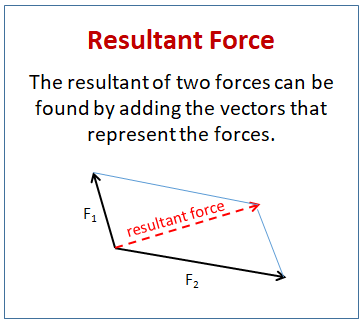The Resultant of Two Forces
Related Pages
Physics: Force
Resultant Forces
Vector Addition
These lessons, with videos, examples, solutions and worksheets, help PreCalculus students learn how to obtain the resultant of two forces using vectors.
The Resultant of Two Forces
When vectors represent forces, their sum is called the resultant. The resultant of two forces
can be found using the methods for adding vectors when the vectors are a geometric representation.
When using methods for the algebraic representation to find the resultant of two forces, it
can be helpful to understand the components of a force.
The resultant of two forces is the single force that has the same effect as the two individual forces acting together. It’s the vector sum of the two forces. To find the resultant of two forces, you need to consider both their magnitudes and their directions.
The following diagram shows how to find the resultant of two forces. Scroll down the page for more examples and solutions on how to obtain the resultant of two forces using vectors.

There are several methods to find the resultant of two forces:
-
Graphical Methods
These methods involve drawing the force vectors to scale and then using geometric constructions. While useful for visualization and rough estimation, they are less precise than analytical methods.
Triangle and Parallelogram Methods -
Analytical Methods
These methods use mathematical formulas (trigonometry and algebra) to calculate the exact magnitude and direction of the resultant force. They are more accurate and preferred for complex problems.
Component Method for Vector Addition
Resultant of two forces at right angles
How to calculate the resultant force from two forces acting at right angles to each other?
Example:
Two forces 300 N at 0 degrees and 400 N at 90 degrees pull on an object.
Answer the following (Use the tail-tip method):
a.Draw a diagram showing the forces acting on the object.
b.Draw a sketch showing the vector sum of two forces.
c.Find the magnitude of the resultant force.
d.Find the direction of the resultant force.
Resultant of two forces not at right angles
How to calculate the resultant from two forces that are not at right angles to each other,
using the cosine and sine rules of triangles.
Try out our new and fun Fraction Concoction Game.
Add and subtract fractions to make exciting fraction concoctions following a recipe. There are four levels of difficulty: Easy, medium, hard and insane. Practice the basics of fraction addition and subtraction or challenge yourself with the insane level.

We welcome your feedback, comments and questions about this site or page. Please submit your feedback or enquiries via our Feedback page.